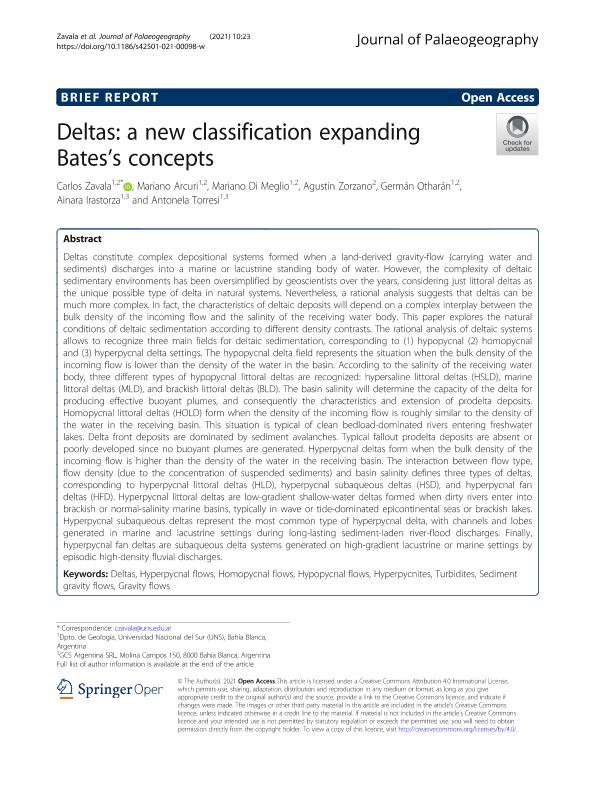Artículo
Deltas: a new classification expanding Bates’s concepts
Zavala, Carlos Alberto ; Arcuri, Mariano Jose
; Arcuri, Mariano Jose ; Di Meglio, Mariano
; Di Meglio, Mariano ; Zorzano, Agustin; Otharán, Germán Aníbal
; Zorzano, Agustin; Otharán, Germán Aníbal ; Irastorza, Ainara
; Irastorza, Ainara ; Torresi, Antonela
; Torresi, Antonela
 ; Arcuri, Mariano Jose
; Arcuri, Mariano Jose ; Di Meglio, Mariano
; Di Meglio, Mariano ; Zorzano, Agustin; Otharán, Germán Aníbal
; Zorzano, Agustin; Otharán, Germán Aníbal ; Irastorza, Ainara
; Irastorza, Ainara ; Torresi, Antonela
; Torresi, Antonela
Fecha de publicación:
06/08/2021
Editorial:
Springer
Revista:
Journal of Palaeogeography
ISSN:
2524-4507
Idioma:
Inglés
Tipo de recurso:
Artículo publicado
Clasificación temática:
Resumen
Deltas constitute complex depositional systems formed when a land-derived gravity-flow (carrying water and sediments) discharges into a marine or lacustrine standing body of water. However, the complexity of deltaic sedimentary environments has been oversimplified by geoscientists over the years, considering just littoral deltas as the unique possible type of delta in natural systems. Nevertheless, a rational analysis suggests that deltas can be much more complex. In fact, the characteristics of deltaic deposits will depend on a complex interplay between the bulk density of the incoming flow and the salinity of the receiving water body. This paper explores the natural conditions of deltaic sedimentation according to different density contrasts. The rational analysis of deltaic systems allows to recognize three main fields for deltaic sedimentation, corresponding to (1) hypopycnal (2) homopycnal and (3) hyperpycnal delta settings. The hypopycnal delta field represents the situation when the bulk density of the incoming flow is lower than the density of the water in the basin. According to the salinity of the receiving water body, three different types of hypopycnal littoral deltas are recognized: hypersaline littoral deltas (HSLD), marine littoral deltas (MLD), and brackish littoral deltas (BLD). The basin salinity will determine the capacity of the delta for producing effective buoyant plumes, and consequently the characteristics and extension of prodelta deposits. Homopycnal littoral deltas (HOLD) form when the density of the incoming flow is roughly similar to the density of the water in the receiving basin. This situation is typical of clean bedload-dominated rivers entering freshwater lakes. Delta front deposits are dominated by sediment avalanches. Typical fallout prodelta deposits are absent or poorly developed since no buoyant plumes are generated. Hyperpycnal deltas form when the bulk density of the incoming flow is higher than the density of the water in the receiving basin. The interaction between flow type, flow density (due to the concentration of suspended sediments) and basin salinity defines three types of deltas, corresponding to hyperpycnal littoral deltas (HLD), hyperpycnal subaqueous deltas (HSD), and hyperpycnal fan deltas (HFD). Hyperpycnal littoral deltas are low-gradient shallow-water deltas formed when dirty rivers enter into brackish or normal-salinity marine basins, typically in wave or tide-dominated epicontinental seas or brackish lakes. Hyperpycnal subaqueous deltas represent the most common type of hyperpycnal delta, with channels and lobes generated in marine and lacustrine settings during long-lasting sediment-laden river-flood discharges. Finally, hyperpycnal fan deltas are subaqueous delta systems generated on high-gradient lacustrine or marine settings by episodic high-density fluvial discharges.
Archivos asociados
Licencia
Identificadores
Colecciones
Articulos(INGEOSUR)
Articulos de INST.GEOLOGICO DEL SUR
Articulos de INST.GEOLOGICO DEL SUR
Citación
Zavala, Carlos Alberto; Arcuri, Mariano Jose; Di Meglio, Mariano; Zorzano, Agustin; Otharán, Germán Aníbal; et al.; Deltas: a new classification expanding Bates’s concepts; Springer; Journal of Palaeogeography; 10; 1; 6-8-2021; 1-15
Compartir
Altmétricas



